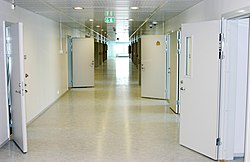
Incarceration inNorway is one of the primary forms of punishment and rehabilitation for individuals convicted of criminal offenses.
Contents
- History
- Prison system
- Penalties in society
- Penalty in prison
- Prison officers
- Prison population
- Problems
- See also
- References
- Further reading
- External links

Norway's criminal justice system is organized around the principles of restorative justice, rehabilitation, and the normalization of daily life in prison. Correctional facilities in Norway focus on maintaining secure custody while supporting the social reintegration of offenders, following the idea that life inside prison should resemble life outside as closely as possible within safety limits.
Per capita, Norway has one of the lowest recidivism rates globally; in 2018, the reconviction rate was 18 percent within two years of release and 25 percent after five years. [1] Per capita, The country also reports relatively low overall crime rates. [2] [3] [4] Norway's prison system houses approximately 3,000 individuals at any given time. [5]
Norwegian law prohibits the use of torture and other cruel, inhuman, or degrading treatment as punishment. Prison conditions generally meet international human rights standards, and independent organizations regularly monitor facilities. Prisoners also have access to an ombudsman who can investigate complaints about public authorities. [6]
Norway does not use capital punishment or traditional life imprisonment. The maximum custodial sentence is 21 years (30 years for crimes against humanity, with life imprisonment applicable only under military law). [4] Courts may extend an offender’s sentence in renewable five-year increments if the individual is judged to remain a significant risk to society. [7]